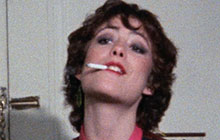|
|
|
|
Smithereens
|
 |
|
It is hard to imagine Susan Seidelman’s Smithereens attracting funding in either
a cinema or TV context today. Its central character, Wren (Susan Berman, who
sadly has only a small subsequent CV in cinema), is the dead opposite of what
is now referred to as a relatable hero, or even anti-hero.
Wren has no special skills and no special dreams. She
expresses an idea of maybe being “associated” with a rock band, perhaps as a
manager, but there is no specific creative drive in this musing. In a prescient
anticipation of online “selfie” culture, Wren simply wants to be a local
celebrity, recognised for being her spunky self – which is why she puts up
photocopied images of herself everywhere she goes, adorned with the leading
question: “Who is this?”
According to Seidelman, looking back at her debut
feature in the retrospection occasioned by a Criterion DVD release, “She wanted to be famous for not
doing anything but being herself”. Wren’s “goal”,
which she pursues with greater or lesser tenacity throughout, is simply to
hitch a ride from New York to Los Angeles, maybe with some possible job or
activity attached. But all this is deliberately left vague and floating by
Seidelman’s loose, episodic narrative.
In another recent interview, Seidelman recalled that,
in the mid 1970s, with her “anthropological” eye, “I started to see a kind of female
character that fascinated me”. On Wren: “She goes about throwing herself into
that world in narcissistic and self-destructive ways, perhaps, but she
certainly does it with energy and courage. That was a side of her that I liked,
and I wanted to make a film about that kind of character.” To capture this character, Seidelman employs a basically naturalistic,
observational, neutral and functional style, neither too rough nor too
affected.
That style switched-up considerably in her subsequent
film, the mainstream breakthrough of Desperately
Seeking Susan (1985), with its touches of urban, “trading places” fairy
tale and (thanks to screenwriter Leora Barish) Céline and Julie Go Boating remake/retake, and its intimations of
the burgeoning “MTV aesthetic” of the era. But both films – as well as a few
others in her subsequent career – focus the theme Seidelman identifies as
“inventing yourself”. The idea reappears, under an extravagant guise, in the
underrated Making Mr Right (1987) –
which, alas, cast her Hollywood career onto rockier ground, in the same
historic year that the box-office “scandal” of Ishtar spelt the effective termination of Elaine May’s brilliant
directorial work.
In Smithereens,
Wren essentially exists from one day to the next, sleeping wherever she can,
once she has been locked out of her apartment for not paying the rent. As a
main character, she isn’t relatable, and she isn’t even terribly likeable,
she’s only out for what she can get – a sign of the early ‘80s punk times. Paul
(Brad Rijn from several Larry Cohen movies of the time), a shy newcomer to NY
who lives in a van, seems a relatively decent, nice guy; he helps Wren out and
takes her in to his “abode” whenever she shows up – but she just as often
ditches him, on alternate nights, for the sake of pursuing the “glamorous punk
rock star” in her vicinity, Eric (musician-writer Richard Hell), who proves
just as fickle, callow and exploitative as her.
Smithereens is constructed as
the series of back-and-forth dealings between these three characters, plus
others who float around them – such as the melancholic, unnamed blonde (Kitty
Summerall) who turns out to be Eric’s lawful wife. In Smithereen’s final freeze-frame, Wren – all other options exhausted
– finds herself inadvertently and inevitably pondering taking up prostitution
as a way to survive life on the streets.
Where did all the women filmmakers – poised between
various kinds of experimentation and the skeletons of popular genres – go, once
the brief boom of the ‘80s was over? Where are they today? Kathryn Bigelow
weathered some storms and lulls and ended up well and truly on her feet in the 2000s.
Seidelman, while surviving in the mainstream industry,
has found herself increasingly typecast, since the 1990s, for particular directorial services: soft erotica, kooky romantic comedy,
“female friendship” and “getting older” stories. These formats tend to
represent, for better or worse, the “female genres” of contemporary Hollywood
in the era of successful, populist screen storytellers like Nora Ephron and
Nancy Meyers. But we can still hope that, for Seidelman now in her mid 60s,
something more energetic and distinctive may yet emerge from an ongoing career.
This review draws on material prepared by Cristina
Álvarez López & myself for the presentations and catalogue of the
Zomerfilmcollege in Antwerp, July 2019.
MORE: “Shady Ladies of the Eighties” |
![]()